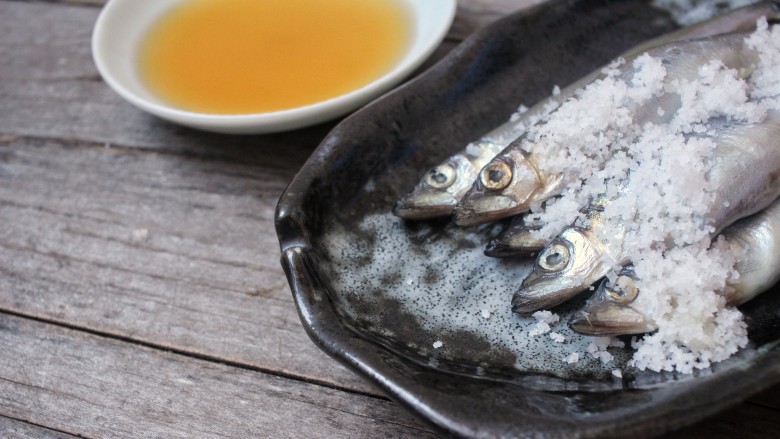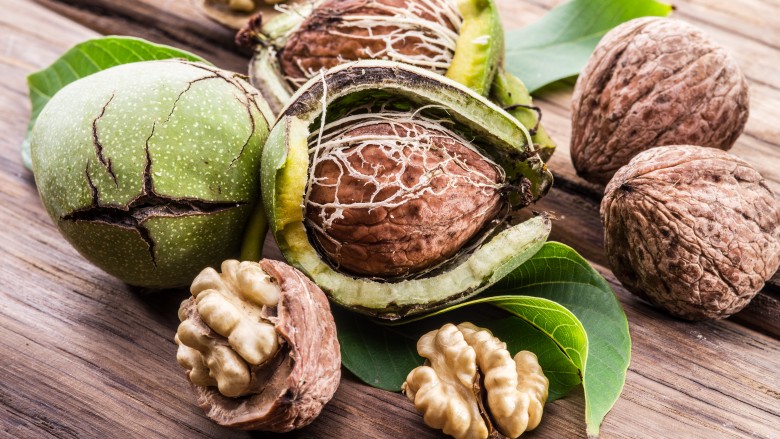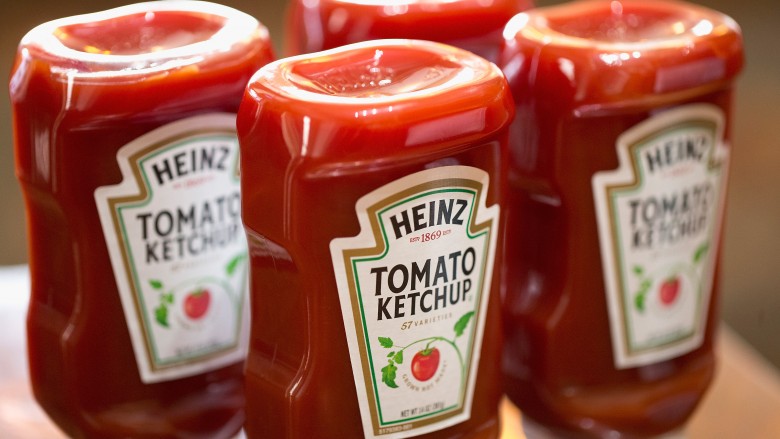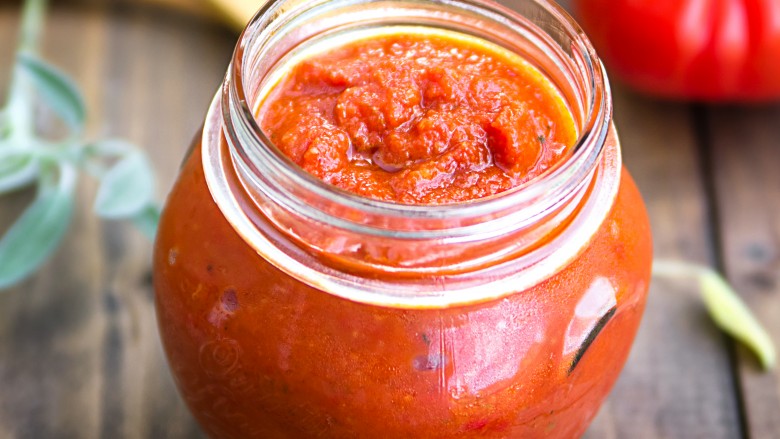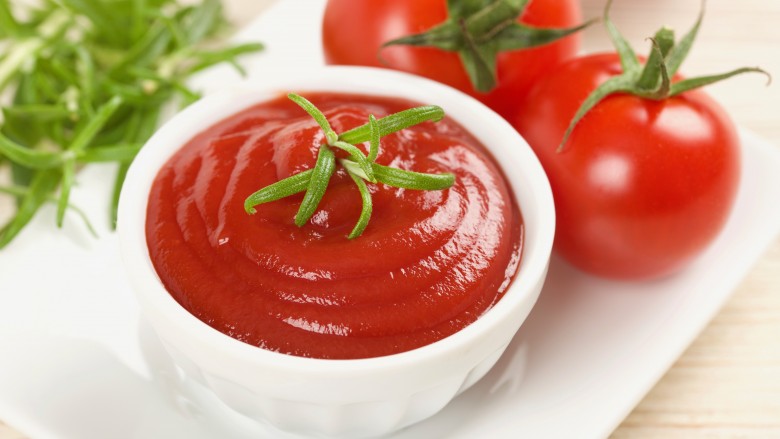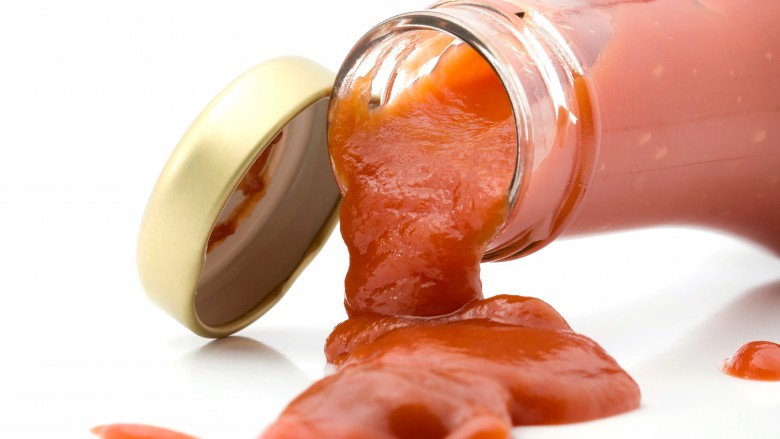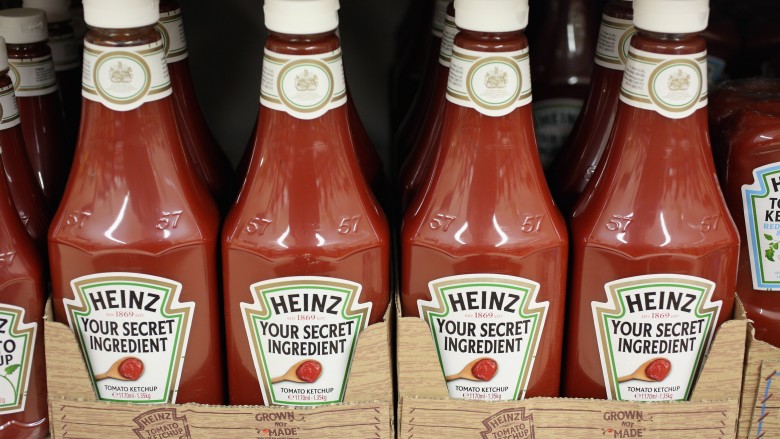The Untold Truth Of Ketchup
No matter what else you love or hate about the kitchen, you probably have a bottle of ketchup in the fridge and a backup or two in the cupboards. There's just something about this staple condiment that makes it an invaluable part of any kitchen, but, let's be honest, you've wondered at least once why it's always called "tomato" ketchup. That seems like it should be a given, but it wasn't always. It turns out that ketchup has had a long, strange, and sometimes controversial road to becoming the well-loved condiment it is today.
It came from Asia and was originally rather fishy
Ketchup wasn't born from the tomato, and ketchup in its earliest forms was absolutely nothing like that bottle of goodness you keep in the fridge. When a Stanford professor started tracing ketchup's journey, he found that the beginning was way back in ancient Asia. Professor Dan Jurafsky found that tomato ketchup is on just one branch of the family tree, and that the condiment actually started out as fermented fish paste. We know because he's found poetry written about the tradition of making a thick paste from fermented fish (and other meats) to use as a flavoring — or condiment, if you like.
According to a history text from 544, the discovery of fermented fish paste came from a Han emperor who sent a representative off in search of the source of an amazing smell he smelled. That source was a pile of discarded fish entrails that had been covered with dirt and left to decay. Amazing. From there came the recipe for one of the first ketchups, which included the stomach, bladder, and intestines of fish, salted heavily and left in a jar to ferment. In about 50 days (or 100 days in the winter or 20 in the hot summer sun), you'd have your condiment.
Gradually, fish and meat gave way to the popularity of fermenting other things, like soy beans. The name "ketchup" came along a bit later, and Jurafsky found that it was sometime in the 18th century that the words "ge-tchup," "kue-chiap," and "ke-tchup" were recorded in the dictionaries of Western missionaries. Trade later brought the idea West, and by the 1740s the various versions of ketchup were all over Europe, made even more popular by the arrival of spices and seasonings.
Jane Austen loved walnut ketchup
Ketchup was originally made from all sorts of crazy things that look completely and utterly foreign to modern eyes. You may never think of Jane Austen in quite the same way once you know that she was particular to a certain kind of ketchup: walnut ketchup. Think of her taking a break from writing Pride and Prejudice for a bit of walnut ketchup smeared on a piece of bread. I should infinitely prefer it plain.
When Austen and her mother lived in a cottage in Chawton, her friend Martha Lloyd lived with them. Lloyd kept a household book, and it's provided a lot of insight into the day-to-day of life at the time. Included in the book is her very own recipe for walnut ketchup, which involved grinding walnuts into a paste then mixing that with vinegar and salt. After fermenting for eight days, it would be boiled, strained, and seasoned with ginger, cloves, nutmeg, pepper, horseradish, and shallots.
Sounds tasty! If you're curious enough to try to make this for yourself, Hunter, Angler, Gardener, Cook has a recipe that you can try. But note that it needs to age for about a year before it really gets good.
Mushroom ketchup is still a thing in Europe
By the time the Asian idea of ketchup made it to Europe, enterprising cooks were finding all sorts of ways to make it their own. In the 18th century, mushroom ketchup was a massive hit, and if you head to a Tesco today, you can still find it on the shelves.
The idea of using mushrooms in ketchup was rooted in something the Europeans were making long before anyone in Europe heard of ketchup: pickled mushrooms. Somewhere along the way, someone realized that the liquid that came from pickling mushrooms could be used again. With a little help, it became mushroom ketchup.
If you're curious about this one, British chef Nigel Slater has come up with a modern take on mushroom ketchup, but it's not for the faint of heart. Besides mushrooms, it also calls for things like anchovies, cider vinegar, onions, and gherkins. (To be fair, it's not that much stranger than Worcestershire sauce.)
The tomato version was touted as medicinal
By the time ketchup made it to American shores, it had undergone another transformation. In the early 19th century, tomato ketchup and tomato sauce were pretty similar, with the main difference being ketchup's longevity. There were a million and one recipes published for making your own tomato ketchup, but the product got an unlikely boost in popularity with a doctor named John Cook Bennett.
Along with his recipes for ketchup and other tomato products, he published lots of literature on the health benefits of regularly eating tomatoes. He claimed they prevented cholera and were the best treatment for, shall we say, gastrointestinal distresses. He also said he was convinced tomato extract would someday be used as a cure-all, and it was his testimony that elevated tomatoes onto America's food radar. Until then, tomatoes had been sort of vaguely distrusted by many people, but when newspapers across the country picked up his claims that tomatoes — and ketchup — were a miracle cure, there was no looking back.
It was originally pretty alcoholic
It's impossible to tell who first stumbled on the idea of making ketchup from tomatoes, but we do know one of the first recipes for tomato ketchup dates to 1812. It came from a doctor named James Mease, who claimed to have gotten the idea from the French. (Historians think he was actually referring to Haitian refugees.) His recipe is notable for a few reasons, and the first is that he didn't call them tomatoes: he called them love apples. The second is that he called for alcohol, and he wasn't the only one. Throughout the 19th century, most of the recipes for tomato ketchup called for things like brandy as a key ingredient, and one recipe from 1901 even specifies that for every gallon of ketchup mix, you should be adding a quart of red wine.
Ketchup became a non-alcoholic condiment when our collective taste preferences shifted to the sweet side. The alcohol and the sugar didn't mix, and using additives to slow fermentation was banned in 1906. Just in case you're curious, though (and you know you are), here's a recipe for ketchup that calls for a healthy dose of bourbon, courtesy of Epicurious.
Why are ketchup bottles clear?
Have you ever wondered why ketchup bottles are clear glass or plastic? Maybe you're so used to seeing those clear bottles that you don't think anything of it. There's actually a reason they're all clear, and it goes back to the middle of the 19th century.
By the mid-1800s, commercial food production was ramping up. In the case of tomato ketchup, it was a potentially dangerous thing. Fresh tomatoes have a short growing season — from the middle of August to the middle of October — and at the time, there weren't many foolproof methods for keeping foods fresh after picking them. Because the demand for ketchup was year-round, tomatoes that were pulled from storage for use in ketchup were often months old. If that sounds unappetizing, it was. Ketchup in particular gained a reputation as being filled with all sorts of nastiness, from mold to bacteria. The preservatives used weren't much better, and some manufacturers started adding things like coal tar to keep ketchup red and semi-fresh.
By the time Henry J. Heinz started making his ketchup, it had a reputation for being a food that you needed to be suspicious of. Cue the clear bottles. Heinz was so proud of the cleanliness of his factories that he gave tours. Then he went a step further and bottled his ketchup in a way that would prove to buyers that his stuff was the real deal.
Ketchup is surprisingly easy to make at home
Ketchup is probably such a staple that you know exactly how much is left and right when to pick up another bottle. Companies like Heinz are such a part of American culture that you probably never even thought about trying to make your own ketchup. But you might be surprised by how easy it is.
This recipe from Delicious magazine will make you two bottles of the tasty red stuff, and it'll be ready in just a couple of hours. Made from allspice, chilies, garlic, red wine vinegar, onions, peppercorns, and a dash of brown sugar, it's a great way to try something new. And if you have a garden and always find yourself wondering to do with all the tomatoes you end up with, this is a great way to use a bunch for something new and fun. (What ketchup-lover in your life wouldn't like a batch of this as a gift?)
There are plenty of variations, too. This recipe from BBC Good Food makes a ketchup on the spicier side. With Tabasco, allspice, cinnamon, and garlic, it's more than just an occasional treat.
Ketchup and hot dog etiquette
Ketchup might be hugely popular, but in at least one city, it's highly polarizing. Get caught putting ketchup on a hot dog in Chicago, and you'll be immediately identified as an outsider. Some might even be offended by your choices.
In Chicago, acceptable hot dog toppings are yellow mustard, tomato, a dill pickle, onions, peppers, a bit of celery salt, and some of the city's trademark neon green relish. But not ketchup. When local chain Portillo's suggested that ketchup should be considered acceptable, too, the internet's food blogs went nuts. When the Chicago Tribune ran a piece claiming that denying ketchup to hot dog-lovers across the city was akin to "foodie fascism," it only fanned the flames.
The Tribune also ran a piece on actual, honest-to-gosh ketchup research, all based in the world of a Northwestern University professor named Bill Savage. Savage set out to find out the roots of the ketchup hatred, and he likened a ketchup-free hot dog to a cultural icon. It's no joke, and he's even spoken at the Chicago Hot Dog Fest on the subject. While there might be plenty of hot dogs there, there's probably not any ketchup.
Can we call it a vegetable?
During the Reagan administration, government officials were debating about what constituted a healthy school lunch program. At the time, one of the suggestions was changing whether or not a dollop of ketchup would be considered to be part of a lunch's vegetable allowance, and not surprisingly, the media grabbed the story and ran with it. Needless to say, the whole thing was met with not a small bit of outrage from all around, including with comments from Senator John Heinz. Heinz — who is, indeed, connected to the Heinz ketchup company, was quoted as saying, "Ketchup is a condiment. This is one of the most ridiculous regulations I ever heard of, and I suppose I need not add that I know something about ketchup and relish — or did at one time."
The science behind pouring it
No matter how much you love ketchup, you probably still leave a little bit in the bottle to be rinsed out before recycling. Pouring ketchup can be a challenge on the best of days, and there's a reason it's the subject of countless gags. Heinz even introduced upside-down bottles to help you, but what's really going on here is some weird science.
Ketchup is a non-Newtonian fluid — it breaks the rules of how liquids and solids should act. Ketchup is both a liquid and a solid, and it changes its density based on how much pressure is applied to it. You know how ketchup goes from being stuck in the bottle to pouring out all over the place? That switch is when it crosses the threshold. Shake a bottle up past that threshold and it becomes 1,000 times thinner than it was on the other side. Are you one of those people who slowly and carefully coaxes your ketchup out of the bottle? Good luck! Science says that's not very effective. It also says that the best method for getting your ketchup is shake the bottle vigorously a few times, then remove the lid and start pouring soon after. (Fun fact: when left to flow naturally, ketchup can reach speeds of 147 feet per hour.)
Science is also finding other solutions to the ketchup problem, like the development of something called Liquiglide. When used in bottles, the ketchup slides right out. In the meantime, there's a nifty little trick that will help with the classic glass bottles. Instead of hitting the bottom of the bottle, hit it near the top. The sweet spot is even marked for you — it's the 57 label on the neck. Tap that a few times, and you'll start the thinning reaction right at the choke point.
There's a reason you think of Heinz
There are countless varieties of mustards, barbecue sauces, and other condiments, but when it comes to ketchup, there's Heinz. From home to restaurants, it's the go-to brand. Why? According to ketchup expert Andrew F. Smith, Heinz didn't just make his factory clean and his product sanitary — he tweaked the recipe to perfection. Ketchup recipes were all over, but he increased the vinegar, raised the sugar, and packed in more tomatoes. All that worked together to create a sweet spot of flavor, mixing sweetness with acidity and umami. Heinz ketchup ended up being that perfect mix that no one has been able to quite match yet.
But wait, there's more! Field research has found that kids in particular love Heinz ketchup because it makes unfamiliar flavors suddenly taste familiar. And when Kansas State University researchers ran an in-depth study on Heinz ketchup and upstart challenger World's Best, they found that when they broke each ketchup down into its composite flavors, Heinz created something magical. According to them, you think of Heinz when you think of ketchup because of a whole host of flavors and textures that blend together with nothing less than a sort of scientific perfection.

